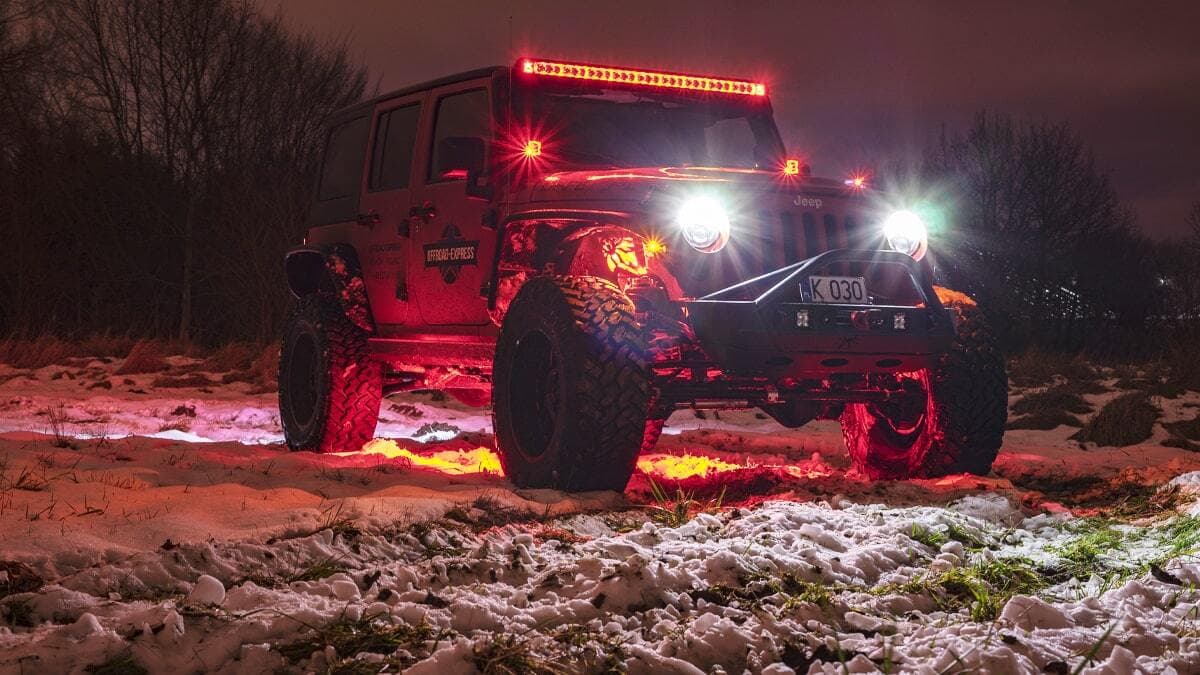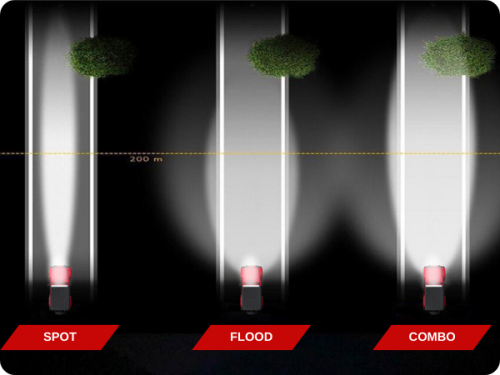
LED lighting for off-road vehicles – How to improve visibility on the trails?
A dense forest, deep ruts, and fallen tree branches – off-road obstacles can take you by surprise, especially after dark. Good visibility is crucial for safe off-roading, and standard headlights often fall short. Investing in additional LED lighting for off-road car can greatly enhance safety and give you more confidence.
So, what lights should you choose to boost your driving comfort and avoid dangerous situations? Let’s take a look at the best solutions for off-roading.
Why you need additional LED lighting on an off-road vehicle
Standard exterior lighting on vehicles, which comes with every car that meets regulations, is designed for road conditions. However, it isn’t built for the challenges of off-roading. Darkness in a completely unlit area filled with various natural obstacles and uneven terrain takes on a whole new meaning. Plus, when you’re out on successful trails or crossings, time seems to fly by. Before you know it, nightfall will be upon you. That’s why adding LED lighting to your off-road vehicle makes driving in tough conditions much safer.
Driving at night in the wilderness is like asking for trouble. Any task around your vehicle in those conditions and with poor lighting feel like wandering through a maze, with traps waiting at every corner. Changing a damaged part, connecting a winch, or setting up a camp becomes frustrating and even risky in poor lighting. That’s why adding LED lighting to your off-road vehicle isn’t just a luxury; it’s an essential upgrade. So, which options should you choose?
Advantages of LED lighting in off-roading
LED technology is currently the best choice for off-road lighting. Its biggest advantage over traditional lights is that the size of the light source doesn’t determine the intensity or quality of the beam. This means that even small LED lights can emit light with similar brightness and power to traditional, larger headlights. It all comes down to the specifications of the light source itself.
Another benefit of LED lights for off-roading is their high energy efficiency. Off-road vehicles, especially those used for expeditions or overlanding, are often loaded with electrical accessories. Any reduction in power consumption is incredibly valuable, helping to optimize the vehicle’s overall energy use.
In addition, LED lighting offers greater efficiency, a longer lifespan than standard bulbs, and better durability against damage and low temperatures. Unlike traditional lights with fragile glass components, LEDs are typically made from reinforced plastic and aluminum. This is especially important in off-road conditions, where flying gravel, water, and sand are just part of the everyday adventure.
Types and uses of additional LED lighting for off-road vehicles
In many cases, additional off-road LED lighting doesn’t have road approval, which means it can’t replace the standard lights on your vehicle. So, don’t use them in the city, on highways, or other public roads unless they have the proper markings. Typically, these accessory lights should be reserved for your off-road adventures.
The variety of off-road lighting models allows you to illuminate nearly every part of your vehicle. Besides the standard spots like the bumper, grille, or roof, you can also find lights mounted on the hood latches, mirror arms, truck bed, or spare tire.
LED lights for off-road vehicles typically come in the form of round halogen lights, rectangular lamps, headlights, or elongated light bars. However, for our off-road use, the most important criterion isn’t just the shape of the light housing, but mainly the beam pattern.

Spotlights (Long-range headlights)
Spotlight beam patterns (often referred to as “spot”) are characterized by a focused beam of light. This means they have a narrow light distribution angle, usually less than 30 degrees. At the same time, they offer a longer light range, reaching up to several hundred meters. This is why they are commonly known as long-range headlights.
This type of focused lighting is especially useful in more open spaces and at relatively higher speeds during off-roading, allowing you to spot obstacles or potential dangers from a greater distance. By seeing them earlier, you won’t have to nervously scan the sides while driving down a forest road.
For this reason, long-range LED lights are usually mounted on the roof or on the bumper guards. Generally, the higher the placement, the further the light can reach. However, there’s a risk that the glare reflecting off the hood of the vehicle can blind you while driving. On the other hand, if you mount them on the bumper, you might get blinded while using the winch.
So, before installing any lamp it’s a good idea to test their placement to see how they perform in real-world conditions. For example, you might find that placing them further back on the roof works better for your vehicle than positioning them directly above the windshield.
Floodlights (Wide beam lights)
Floodlight beam patterns (often just called “flood”) are a type of lighting that provides a wide beam of light. Generally, they spread light at an angle of about 120 degrees with a shorter range (around 50–70 meters), making them great for work and auxiliary lighting. They also feature a softer glow, with less sharp edges and shadows.
It offers great visibility over a wide area around the vehicle and along the roadside. It’s ideal for off-roading in forested regions, where obstacles are hiding ahead, and you need to navigate through them carefully at a slow pace.
It’s a good idea to also install floodlights on the sides and rear of your off-road vehicle. For this, you should choose small yet powerful lights that will help mainly when reversing and doing repairs at night. Angle them downward and spread them out to illuminate as wide an area as possible without causing glare that could affect your vision.
Combo lights – The best of both worlds
The optimal solution for deciding between focused or dispersed lighting for your off-road vehicle is combo lights. These typically come in the form of LED bars, which are long panels equipped with dozens or even hundreds of LED bulbs.
This design allows for the combination of two types of light beams in one lamp. The focused beam is located in the center of the bar, while the dispersed light is found on the outer edges. As a result, you get concentrated lighting for long distances straight ahead, along with a wider view to the sides of the vehicle.
When combined with rear lighting, combo lights provide the most versatile option for off-roading, including expeditions, crossings, overlanding, and touring
What LED lighting should you choose for your off-road vehicle?
Before buying a specific model of LED lighting for your off-road vehicle, there are a few important things to consider. First, of course, are the light source parameters, including the beam angle and lumen output. Additionally, the waterproof rating of the housing is very important, as it should allow for easy immersion of the vehicle in mud and water.
Finally, the installation method of the lights and the wires used are also important. It’s ideal if the wires are reinforced and protected against damage. Be sure to route them sensibly to avoid close contact with the wild environment. For convenience, think about how to connect them to the rest of your vehicle’s lighting. If you’re not sure about installation process, it’s a good idea to consult a mechanic or an electrician for assistance.













Comments ()